Irish Australians
Irish Australians (Irish: Gael-Astrálaigh) are an ethnic group of Australian citizens of Irish descent, which include immigrants from and descendants whose ancestry originates from the island of Ireland.
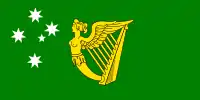 | |
| Total population | |
|---|---|
| c. 7,000,000 (30% of the Australian population of partial Irish ancestry)[1][2] 80,000 (by birth, 2011)[3] 2,087,800 (self-declared Irish ancestry, 2011; 10.4% of the Australian population) | |
| Regions with significant populations | |
| Sydney, Melbourne, Brisbane, Perth | |
| Languages | |
| Australian English, Hiberno-English, Ulster Scots, Irish | |
| Religion | |
| Roman Catholic (majority), Protestantism (minority) | |
| Related ethnic groups | |
| Irish people, Overseas Irish Anglo-Celtic Australians, Scottish Australians, Welsh Australians, English Australians, Cornish Australians, Manx Australians, Irish Americans, Irish Britons, Irish New Zealanders |
Irish Australians have played a considerable part in the history of Australia. They came to Australia from the late eighteenth century as criminals but most were prisoners of war, mainly those who fought in the 1798 Irish rebellion for independence and settlers who could not find a life during the Irish famine and the harsh years in Ireland afterwards. They contributed largely to Australia's development in many different areas. In the late 19th century Irish Australians constituted up to a third of the country's population.[4]
There is no definitive figure of the total number of Australians with an Irish background. At the 2011 Australian census, 2,087,800 residents identified themselves as having Irish ancestry either alone or in combination with another ancestry.[5] This nominated ancestry was third behind English and Australian in terms of the largest number of responses and represents 10.4% of the total population of Australia. However this figure does not include Australians with an Irish background who chose to nominate themselves as 'Australian' or other ancestries. The Australian embassy in Dublin states that up to 30% of the population claim some degree of Irish ancestry.[6]
History
Demographic history
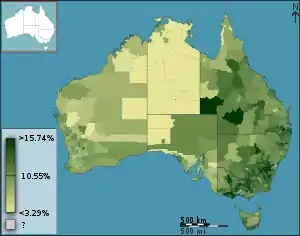
Around 40,000 Irish convicts were transported to Australia between 1791 and 1867, including at least 325[7] who had participated in either the Irish Rebellion of 1798, the rebellion of 1803 or the Young Ireland skirmishes in 1848. Once in Australia, some were involved in the 1804 Castle Hill convict rebellion. Continual tension on Norfolk Island in the same year also led to an Irish revolt. Both risings were soon crushed. As late as the 1860s Fenian prisoners were being transported, particularly to Western Australia, where the Catalpa rescue of Irish radicals off Rockingham was a memorable episode.[8]
Other than convicts, most of the laborers who voluntarily emigrated to Australia in the 19th century were drawn from the poorest sector of British and Irish society. After 1831, the Australian colonies employed a system of government assistance in which all or most immigration costs were paid for chosen immigrants, and the colonial authorities used these schemes to exercise some control over immigration. While these assisted schemes were biased against the poorest elements of society, the very poor could overcome these hurdles in several ways, such as relying on local assistance or help from relatives.[9]
Most Irish emigrants to Australia were free settlers. The 1891 census of Australia counted 228,000 Irish-born. At the time the Irish made up about 27 percent of the immigrants from the British Isles.[10] The number of Ireland-born in Australia peaked in 1891. A decade later the number of Ireland-born had dropped to 184,035. Dominion status for the Irish Free State in 1922 did not diminish arrivals from Ireland as Irish people were still British subjects. This changed after the Second World War, as people migrating from the new Republic of Ireland (which came into being in April 1949) were no longer British subjects eligible for the assisted passage. People from Northern Ireland continued to be eligible for this as British citizens. Only during the 1960s did migration from the south of Ireland reduce significantly. By 2002, around one thousand persons born in Ireland – north and south – were migrating permanently to Australia each year. For the year 2005–2006, 12,554 Irish entered Australia to work under the Working Holiday visa scheme.
Irish and Aboriginal People
It has been argued that Irish Australians and Aboriginal people (including those of mixed descent) feel that there is a historical and sentimental link between the two groups. The shared oppression of Aboriginal and Irish people by the British is seen as giving them common historical ground.[11]
The historian Patrick O'Farrell argued that (in contrast to other colonists) Irish Catholics treated the Aborigines as equals, as evidenced by their willingness to intermarry, thus giving rise to the Irish surnames prominent among Aboriginal activists.[12]
This argument has been questioned. It has been pointed out that under the new colonial and state administrations, a European-style surname was required for official records relating to Aboriginal people. The local police (often of Irish stock) collected the relevant census data and allocated their own names to Aboriginal people for official purposes. In addition, however, many such policemen fathered children to casual or long-term partners from Aboriginal communities.[11]
The assumption that the Irish were less violent than other colonists has also been questioned, since Irishmen were among the bushrangers, squatters, police, timber getters and others known for violence against Aborigines.[11]
Orphans
Over four thousand young female orphans from Irish workhouses were shipped to the Australian colonies at the time of the Great Famine (1848–50) to meet a demand for domestic servants. Some settlers greeted them with hostility and some were exploited or abused by employers and others. Although a number eventually died in poverty, others made upwardly mobile marriages, often surviving older husbands to experience long widowhoods. The Catholic Church only became involved in the 1870s, when its relief agencies in England were overwhelmed with Irish immigration. Even so, only about 10% of the resettlements were through Catholic agencies until after World War II. Australian Catholic groups began importing children in the 1920s to increase the Catholic population, and became heavily engaged in placing and educating them after World War II. The practice quietly died out during the 1950s.[13][14]
Irish language
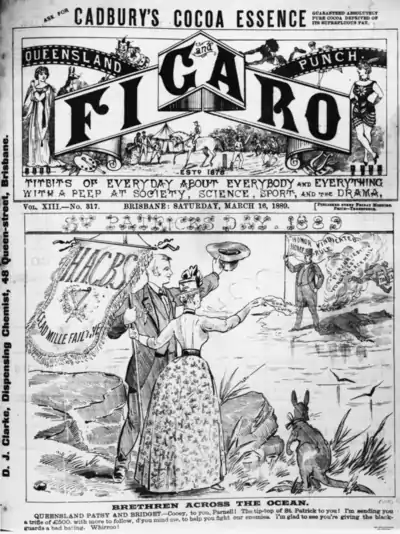
The first convicts and soldiers to arrive in Australia included a large number of Irish speakers, an example being private Patrick Geary, who in 1808 acted as court interpreter for Patrick Henchan, a convict accused of theft.[15] An account from 1800 refers to convicts speaking Irish among themselves (this being regarded as evidence of conspiracy), and it was acknowledged in the 1820s that priests could not perform their duties in the colony of New South Wales without a knowledge of the language.[16] There is a reference to Irish-speaking bushrangers in Van Diemen's Land in the early nineteenth century.[17]
The gold rushes of the 1850s attracted many Irish to the colony of Victoria, with a high proportion of Irish speakers. An Irish-speaking priest, Fr Stack, was appointed to minister to Irish miners in the gold-rush locality of Bendigo.[18] Irish immigration was at its height in the 1860s, the main counties of origin being Clare, Tipperary, Limerick and Kilkenny, all of them areas where the language was still strong.[19] Irish continued to be spoken in Australian country districts where the Irish had settled, and there is some evidence of its being transmitted to the next generation.[20][21]
The Gaelic Revival in Ireland at the end of the nineteenth century found a response in Melbourne and Sydney, with branches of the Gaelic League being established. The 1970s saw a renewal of interest in the language, chiefly among Australians of Irish descent,[22] and there is now a network of Irish speakers in the major cities. The Department of Celtic Studies at the University of Sydney offers courses in Old Irish and Modern Irish, and Newman College (University of Melbourne) houses a collection of books and manuscripts in Irish often used by scholars.[23] Australians have published fiction, poetry and journalism in Irish.
Politics
Although Catholic Irish were not generally politically powerful, the large number of Irish combined with universal male suffrage made it possible for Irish to sometimes gain office, such as the Victorian premiers John O'Shanassy (1857, 1858–59, 1861–63) and Charles Gavan Duffy (1871–72). Peter Lalor was the leader of the 1854 Eureka Rebellion, later a conservative member of parliament.
Before 1890, Irish Catholics opposed Henry Parkes, the main liberal leader, and free trade, since both represented Protestant, English landholding and wealthy business interests. In the great strike of 1890 Cardinal Moran, the head of the church, was sympathetic toward unions, but Catholic newspapers were critical of organised labour throughout the decade. After 1900, Catholics joined the Labor Party because its stress on equality and social welfare appealed to people who were workers and small farmers. In the 1910 elections Labor gained in areas where the concentration of Catholics was above average, and the number of Catholics in Labor's parliamentary ranks rose.[24]
World War I
Irish Catholics comprised a quarter of Australia's population in the early 20th century. They were largely working-class and voted for the Labor Party. The referendum on conscription in 1917, following the Easter Uprising in Dublin, caused an identification between the Irish, Sinn Féin, and the anti-conscription section of Labor. Pro-conscription forces exploited this, denouncing outspoken anti-conscription Catholics, such as Archbishop Mannix, and T. J. Ryan, the Premier of Queensland, for disloyalty. In general, Protestants, armed with the authority of tradition, championed the idea of Australia as an integral part of the Empire; and Catholics, freed from that authority by their Irish origins and their working-class affiliations, looked to the future by placing Australia first and the Empire second. There was no simple correlation between Catholicism, Protestantism and conscription, but the idea of an anti-conscription Catholic-Labor alliance stuck for many years.[25]
Mid Twentieth-Century Labor Politics
The Labor Party remained for many decades close to its working-class Irish Catholic roots. Labor governments were usually dominated by leaders of Irish ancestry, such as Prime Ministers James Scullin (1929–31), John Curtin (1941–45) and Ben Chifley (1945–49) and much later Paul Keating (1991–96). The same was true of many state governments such as the New South Wales administrations led by premiers James McGirr (1947–52), Joseph Cahill (1952–59), and Jack Renshaw (1964–65). All three premiers were of Irish Catholic stock. Conversely, conservative parties contained few Irish Catholics (with the exception of Joseph Lyons, conservative Prime Minister 1932–39; and even Lyons defected from Labor, having been an ALP Premier of Tasmania during the 1920s). Australia thus had political leaders at the highest level of Irish Catholic descent decades before other Anglophone countries such as the United States.
Arthur Calwell, minister for immigration in the Chifley government and leader of the federal opposition from 1960 to 1967, strongly identified with his Irish ancestry and learned Gaelic.
Status
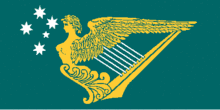
Walker (2007) compares Irish immigrant communities in the United States, Australia, New Zealand, Canada and Great Britain respecting issues of identity and 'Irishness.' Religion remained the major cause of differentiation in all Irish diaspora communities and had the greatest impact on identity, followed by the nature and difficulty of socioeconomic conditions faced in each new country and the strength of continued social and political links of Irish immigrants and their descendants with the old country. From the late 20th century onward, Irish identity abroad became increasingly cultural, nondenominational, and nonpolitical, but many emigrants from Ulster (and especially from Northern Ireland) stood apart from that trend.
For much of the 19th and the 20th centuries, Irish Australians, particularly but not exclusively Catholics, were treated with suspicion in a sectarian atmosphere. The outlaw Ned Kelly (1855–80) achieved the status of a national folk hero; ballads, films and paintings have since 1878 perpetuated the legend.[26] Kelly, who was hanged for murder, is often viewed romantically as the sort of treatment Irish Catholics in Australia could expect. In reality, however, most of the Irish were urban workers who experienced less official discrimination in Australia than they had at home in Ireland, and many Irish Australians (Catholic and Protestant) rose to positions of wealth and power in the colonial hierarchy. Many Irish men, for example, entered law, the judiciary and politics, and in Ned Kelly's time, 80% of the Victorian police were Irish-born, and half of those had served in the Royal Irish Constabulary. In major cities such as Melbourne and Sydney, Irish social and political associations were formed, including the Melbourne Celtic Club, which survives today. The Irish settler in Australia, both voluntary and forced, was crucial to the survival and prosperity of the early colonies both demographically and economically. 300,000 Irish free settlers arrived between 1840 and 1914. By 1871, the Irish were a quarter of all overseas-born.
St. Patrick's Day
O'Farrell (1995) demonstrates the importance of St. Patrick to the Irish, whether northern or republican, Protestant or Catholic, and how Australian manifestations of the Irish festival evolved. St. Patrick's Day became an expression of Irish identity and was emblematic of Irish culture and traditional separatism that migrated with the Irish to Australia. The early immigrants to Australia from Ireland were mainly members of penal colonies; assemblies or any such expression of Irish culture were not permitted. St. Patrick's Day at first was the exception, because it was not highly political, was ecumenical and was subordinate to the wider recognition of Britain. In a series of letters, a P. Cunningham, stated that a St Patrick's Day "jubilee" Ball was being held in Sydney in 1826.[27] The situation changed, however, in the 1830s with the growth of wealthy Irish Catholic emancipists and the introduction of Irish Catholic priests. These factors gave rise to conflicts and tensions that were to remain constant thereafter as the rise and decline of domestic Irish political movements influenced the Irish population in Australia. With the outbreak of World War I, imperatives imposed by the demands of war overshadowed Australian Irish sentiment.[28]
Orange
The idea of fraternity and how to organise it was one of 19th-century Europe's invisible exports to the New World. Fitzpatrick (2005) explores the international diffusion of the Loyal Orange Institution, with comparative reference to Freemasonry, its main model. Three alternative explanations are discussed for its appeal outside Ireland: that it facilitated the assimilation of emigrants, transmitted 'tribal' Irish animosities to fresh contexts, or adapted itself to preexisting sectarian rivalries abroad. These hypotheses are tested using evidence from South Australia, where Orangeism flourished in the absence of heavy Ulster Protestant immigration. A collective profile of Orange South Australia is derived from lodge records showing age, religious denomination, and occupation, and the appeal of Orangeism is related to local political and religious contexts. In this case, Orangeism was primarily an export of organisational techniques rather than Irish personnel or bigotry.[29]
Catholic clergy and nuns
The Catholic Church in Australia maintained a strong Irish identity, especially in the decades from the 1880s to the 1960s when state aid for church schools was withdrawn and the Church maintained a separate and separately funded school system. The leadership of the Australian Church was almost entirely Irish from 1883 to 1940, prominent Irish-born bishops including Cardinal Moran and Archbishop Kelly in Sydney, Archbishops Carr and Mannix in Melbourne and Archbishop Duhig in Brisbane. Many of the Catholic schools were run and staffed by Irish orders of nuns such as the Sisters of Mercy and Brigidines and Irish orders of brothers such as the Christian Brothers and Patrician Brothers. The Sisters of Charity worked in hospitals.
McGrath (1995) demonstrates the success of the Catholic nuns who arrived in Parramatta, New South Wales, from Ireland in 1888, noting their group's growth from nine newcomers into a flourishing congregation of over two hundred women within sixty years. By the 1950s this group of women religious was responsible for 24 primary schools, five secondary schools, and two orphanages. In Australia they carried on the Irish tradition of the Sisters of Mercy and lived a monastic lifestyle. Their sparsely furnished bedrooms were referred to as cells. There was little or no heating. The sisters' spiritual practices reflected the 17th-century school of spirituality.
Their relationship to the clergy was one of devotion, dedication, and subordination, thus reflecting the status of women in the larger population. It was societal pressures from without that eventually led to the decline of the Sisters of Mercy as Australia moved into the 1960s. Radical re-evaluations forced a restructuring of the Catholic Church as a whole, and a rethinking of what kinds of service the Church would require in modern times.[30]
Media
The Irish Echo (Australia) is a newspaper available in print and online, covering Irish news and other matters of Irish interest.[31]
Tinteán is an online journal directed chiefly at Irish Australians. Its stated aim is to provide serious comment and an independent perspective on a wide range of Australian/Irish topics. It publishes some material in the Irish language.[32]
An Lúibín is a fortnightly Irish-language newsletter, distributed online in Australia and overseas. It deals with language matters and also contains articles on folklore, literature and current affairs.[33]
Sports
Irish Catholics have been the nation's largest minority throughout most of Australia's history. Their resistance to the elite Anglocentric establishment has keenly marked the development of sport. Mostly working class, the Irish played sports such as rugby league and Australian Rules football, while the Protestant majority often preferred cricket, soccer, rugby union and boxing. The tensions and contrasts between these two sporting cultures eventually built the attitudes and beliefs toward games and sports that Australians share today.[34]
Irish soccer clubs in Australia include:
- Victoria
- St Kilda Celts[35]
- Geelong Celtic (defunct)
- Ulsterville (defunct)
- Kew Celtic (defunct)
- New South Wales
- South Lismore Celtic
- Celtic United
- Northern Territory
- Western Australia
- Shamrock Rovers Perth
- East Perth FC
- Emerald FC
- Celtic Australis FC Perth Lions
- South Australia
- Adelaide Celtic (defunct)
Present day
At the 2006 Census 50,255 Australian residents declared they were born in the Republic of Ireland and a further 21,291 declared to have been born in Northern Ireland.[36] Cities with the largest Irish-born populations were Sydney (12,730), Melbourne (8,950) and Perth (7,060).[37]
At the 2011 Census 2,087,800 Australians (10.4% of the total population) declared they had Irish ancestry either alone or in combination with another ancestry; only Australian and English ancestries were more frequently nominated.[5]
According to census data released by the Australian Bureau of Statistics in 2004, Irish Australians are, by religion, 46.2% Roman Catholic, 15.3% Anglican, 13.5% other Christian denomination, 3.6% other religions, and 21.5% "No Religion".
Irish Australian settlement patterns are not significantly different from those of the Australian population as a whole – that is, a third live in New South Wales and a quarter live in Victoria – except that around 22 per cent live in Queensland (compared to only 18 per cent of the general population). Relatively few as a proportion reside in Western Australia (7.6 per cent of Irish Australians compared to 9.9 per cent of the general population).
The 2001 Australian census recorded that persons reporting some Irish Australian ethnicity accounted for 10.7 per cent of all responses in the Australian Capital Territory (42,540 responses), 10.2 per cent in Victoria (469,161 responses), 9.9 per cent in New South Wales (622,944), 9.7 per cent in Queensland (433,354), 7.8 per cent in Tasmania (42,552), 7.6 per cent in Western Australia (171,667), 7.5 per cent in the Northern Territory (18,325) and 6.7 per cent in South Australia (119,063).
Irish language use
In the 2011 Census 1,895 persons were reported as using Irish as a household language, most of them in Sydney and Melbourne.[38] This represents an increase from the figure of 918 in the 2006 Census.[39] There are no official statistics regarding the use of Irish outside the home.
Popular culture
The Australian miniseries and historical drama Against the Wind deals with both the British rule of Ireland, and the development of New South Wales and Australia. Ruth Park's 1948 book The Harp in the South portrays the life of a Catholic Irish Australian family living in a Sydney slum. Other shows relating to Irish Australians include The Last Outlaw and Brides of Christ.[40]
Notable people of Irish descent
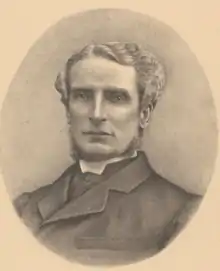
- Ned Kelly, Bushranger and outlaw best known for wearing a homemade suit of armour.
- Peter Lalor, Irish born Australian rebel and, later, politician who rose to fame for his leading role in the Eureka Rebellion.[41]
- George William Torrance, Composer of church music.
- Alan Joyce, Current CEO of Qantas, born in Ireland and immigrated to Australia in 1996.[42]
- Jim Stynes, Australian Rules Footballer and Brownlow Medallist. Born in Ireland and immigrated to Australia in the 1980s.[43]
- Johnny Logan, double-time winner of the Eurovision Song Contest, born in Melbourne.[44]
See also
References
- "Minister for Foreign Affairs, Dermot Ahern T.D., announces Grants to Irish Community Organisations in the Southern Hemisphere". DFA. 26 September 2007. Archived from the original on 28 July 2013.
- "Ancestry Information Operations Unlimited Company – Press Releases". www.ancestryeurope.lu. Archived from the original on 7 September 2017. Retrieved 11 October 2017.
- "Ireland country brief". Department of Foreign Affairs. Retrieved 11 October 2017.
- Rourke, Alison (17 March 2013). "Ireland: Australia is the land of plenty for the biggest wave of Irish emigrants in a generation". The Guardian. Retrieved 11 October 2017 – via www.theguardian.com.
- "ABS Ancestry". 2012.
- Trade, corporateName= Department of Foreign Affairs and. "Australian Embassy in". www.ireland.embassy.gov.au. Retrieved 11 October 2017.
- "Irish Rebels to Australia 1800 – 1806". Mayberry. Retrieved 16 November 2018.
- Bruce Rosen, "The 'Catalpa' Rescue", Journal of the Royal Australian Historical Society 1979 65(2): 73–88,
- Richards, E (1993). "How did poor people emigrate from the British Isles to Australia in the nineteenth century?". Journal of British Studies. 32 (3): 250–79. doi:10.1086/386032. JSTOR 176082.
- T. Jordan-Bychkov, Australia, 2009, p. 44
- McGrath, Ann (2010). "Shamrock Aborigines: the Irish, the Aboriginal Australians and their children". Aboriginal Australia. ANU. 24: 55–84.
- O’Farrell 2001, p. 72
- Trevor McClaughlin, "Lost Children? Irish Famine Orphans in Australia", History Ireland 2000 8(4): 30–34,
- Barry M. Coldrey, "Child Migration and the Catholic Church", Journal of the Royal Australian Historical Society 1993 79(3–4): 199–213
- Hall, p. 238.
- O’Farrell, p. 27.
- The bushrangers in question were named Scanlan and Brown. A third member of the gang, an Englishman named Richard Lemon, was said to have killed Scanlan because he was tired of hearing him and Brown speaking Irish together. Hughes, p. 227.
- Noone, p.41.
- Noone, p. 12. See also the discussion in Fitzgerald regarding the state of Irish in Ireland at the time.
- Noone, p. 44.
- Ó Nuadháin, Val agus Ryan, Colin: 'Nioclás Ó Domhnaill: Laoch na Gaeilge san Astráil' in Feasta, Bealtaine 2009.
- Noone, pp. 148–163.
- The O'Donnell Collection: "Collections: Irish studies collection". St Mary's Newman Academic Centre, University of Melbourne. Retrieved 14 April 2017.
- Celia Hamilton, "Irish-Catholics of New South Wales and the Labor Party, 1890–1910", Historical Studies: Australia & New Zealand 1958 8(31): 254–267
- D. J. Murphy, "Religion, Race and Conscription in World War I", Australian Journal of Politics & History 1974 20(2): 155–163; Alan D. Gilbert, "Protestants, Catholics, and Loyalty: an Aspect of the Conscription Controversies, 1916–17", Politics 1971 6(1): 15–25,
- Seal, Graham (2002). Tell 'em I Died Game: The Legend of Ned Kelly l. Melbourne: Hyland House Publishing. ISBN 978-1864470475.
- Frank.Crowley,"Colonial Australia: A documentary history of Australia 1", Thomas Nelson Pty Ltd, Melbourne 1980: 356
- Patrick O'Farrell, "St Patrick's Day in Australia", Journal of the Royal Australian Historical Society'‘ 1995 81(1): 1–16
- David Fitzpatrick, "Exporting Brotherhood: Orangeism in South Australia", Immigrants & Minorities 2005 23(2–3): 277–310, 34p.
- Sophie McGrath, "Women Religious in the History of Australia 1888–1950: a Case Study – the Sisters of Mercy Parramatta", Journal of the Royal Australian Historical Society 1995 81(2): 195–212
- Irish Echo (Australia's Irish Newspaper): http://www.irishecho.com.au/
- Tinteán: http://www.tintean.org.au
- An Lúibín can be found at the website of the Irish Language Association of Australia: http://www.gaeilgesanastrail.com.
- Peter A. Horton, "The 'Green' and the 'Gold': The Irish-Australians and Their Role in the Emergence of the Australian Sports Culture", International Journal of the History of Sport 2000 17(2–3): 65–92
- Official Website of the St Kilda Celts
- "The People of Australia – Statistics from the 2006 Census" (PDF). www.dss.gov.au. Department of Immigration and Citizenship.
- Statistics, c=AU; o=Commonwealth of Australia; ou=Australian Bureau of. "Australian Bureau of Statistics, Australian Government". www.abs.gov.au. Retrieved 11 October 2017.
- Special Broadcasting Service (SBS): http://www.sbs.com.au/news/census/. Prompts: 'Location,' 'All other languages,' 'Irish'.
- Statistics, c=AU; o=Commonwealth of Australia; ou=Australian Bureau of. "Redirect to Census data page". Retrieved 11 October 2017.
- Reid, Richard. "Irish in Australia essay". www.nma.gov.au. National Museum of Australia. Retrieved 10 December 2018.
- http://adbonline.anu.edu.au/biogs/A050059b.htm
- Snow, Deborah (8 October 2011). "Staying the course". The Sydney Morning Herald. Retrieved 8 October 2011.
- "Speaker Jim Stynes". Icmi.com.au. Retrieved 20 March 2012.
- Thompson, Dave. "Johnny Logan". allmusic. Retrieved 16 May 2020.
Further reading
- Fitzgerald, Garrett, 'Estimates for baronies of minimal level of Irish-speaking amongst successive decennial cohorts, 117–1781 to 1861–1871,’ Volume 84, Proceedings of the Royal Irish Academy 1984
- Hall, Barbara, Death or Liberty: The Convicts of the Britannia, Ireland to Botany Bay, 1797 (Hall 2006)
- Hogan, James Francis (1888). . Melbourne: George Robertson & Co.
- Hughes, Robert. The Fatal Shore. London: Routledge (1987)
- Jupp, James. The Australian People: An Encyclopedia of the Nation, its People and their Origins (2002)
- Martin, Arthur Patchett (1889). . Australia and the Empire (1 ed.). Edinburgh: David Douglas. pp. 135–156.
- Noone, Val, Hidden Ireland in Australia (Ballarat Heritage Services 2012)
- O'Farrell, Patrick, Letters from Irish Australia (New South Wales University Press, 1984.)
- O'Farrell, Patrick. The Irish in Australia: 1798 to the Present Day (3rd ed. Cork University Press, 2001)
- Wells, Andrew, and Theresa Martinez, eds. Australia's Diverse Peoples: A Reference Sourcebook (ABC-CLIO, 2004)
External links
- Reid, Richard (2012). "Irish in Sydney from First Fleet to Federation". Dictionary of Sydney. Dictionary of Sydney Trust. Retrieved 4 October 2015.
- Kildea, Jeff (2012). "Celebrating St Patrick's Day in nineteenth-century Sydney". Dictionary of Sydney. Dictionary of Sydney Trust. Retrieved 5 October 2015.
- Documentary: The Irish In Australia: The Beat of a Distant Drum